Home » Solar Basics » What is Solar Inverter?
What is Solar Inverter?
The solar inverter is the core component of the solar photovoltaic system. When sunlight hits the solar panels, the power generated by these panels can only be direct current, and what we need is alternating current, because most electrical equipment uses Alternating current, at this time, the role of the solar inverter becomes apparent. Its main function is to convert DC power generated by solar panels into AC power for domestic, industrial or commercial use, or for feedback into the grid. The design of the inverter must be efficient and reliable to ensure the stability and economy of the solar system. In modern photovoltaic systems, the inverter is not only an energy conversion device, but also often has a communication interface that can be connected to the smart grid system to achieve remote monitoring and management. Through these functions, the inverter facilitates the interaction between the photovoltaic power generation system and the power grid, increasing the intelligence and automation level of the system.
Solar panels produce direct current (DC). Almost all customer devices use alternating current (AC). The main function of an inverter is to convert DC into AC. There are two types of inverters: those that are tied to the grid and those that are stand-alone inverters. We shall be discussing only inverters that tie into the grid. Inverters come in a large array of sizes from a home inverter shown on the right to a commercial inverter on the right, to a utility-size mega-watt inverter shown below.
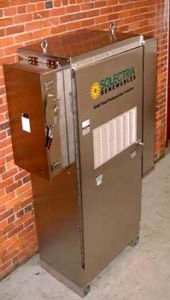
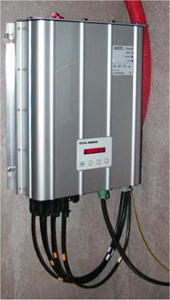
Homes and businesses that have a grid-tied solar system sell the excess electricity that they generate back to the utility. This is known as "netmetering". The entity that owns the solar equipment receives compensation from the utility for the outflow of power. For example if during a month, a solar power system feeds 500 kilowatt-hours into the grid and uses 950 kilowatt-hours (approximately the national average) from the grid. It would only owe 450 kilowatt-hours worth to the utility.
A two-way meter is required for net metering. In essence, when excess solar power is generated, the inverter feeds the grid through the meter, which runs backward selling the power back to the utility at the same price as it is purchased. Net-metering policies vary somewhat from state to state. Inverters do not provide backup power during power outages. For safety reasons, if the grid has lost utility power, the inverter will automatically shut down to prevent the current it produces from harming workers who are sent to restore power.
Solar inverters perform three major functions: as mentioned above they convert the current from DC to AC, they ensure that the solar current and voltage are synchronized with the grid, and they perform Maximum Power Point Tracking (MPPT). Inverters take the DC power from the solar string (typically 300 to 600 volts DC) and invert it to AC power so it can be fed into the grid. The inverter synchronizes its frequency with that of the grid (e.g. 60 cycles) using a local oscillator. It must also match the voltage to the grid voltage. The inverter's AC phase angle must be within 1 degree of the power grid’s AC. The inverter has an onboard computer which will sense the grid's AC current waveform, and output a voltage to correspond exactly to the grid's. The Power-One inverter shown on the right supports utility-scale grid installations.
MPPT - Solar inverters include MPPT (Maximum Power Point Tracking) which enables the inverter to extract an optimal amount of power from the solar string by calculating the array's Maximum Power Point (MPP). Each string of solar panels will have its own MPP. MPPT seeks the "unique current" that the inverter will draw from the string optimize power output (power equals voltage times current).
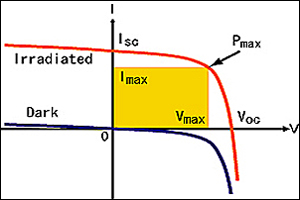 In the graph pictured on the right below, V-max is determined by the relatively constant string voltage (the goal is 600 volts - the maximum allowed in the US). I-max is calculated by the inverter to output P-max - the MPP. To find the point where the string produces maximum power, the inverter uses a trial and error algorithm adjusting the current it intakes in one direction and then another. If the power increases, it keeps going in that direction.If the power decreases, it reverses its direction. This is a dynamic situation as the string voltage can vary over time, such as when a cloud obstructs the sun's radiance. Each inverter has a Peak Power Tracking Voltage rating. This represents the DC voltage "range" in which the inverters' MPPT will operate. The installation designer must configure the strings so that during most of the year the voltage of the strings is within the Peak Power Tracking Voltage range. This can be a challenging task as string voltages can fluctuate as much as 35% as a result of swings in ambient temperature.
In the graph pictured on the right below, V-max is determined by the relatively constant string voltage (the goal is 600 volts - the maximum allowed in the US). I-max is calculated by the inverter to output P-max - the MPP. To find the point where the string produces maximum power, the inverter uses a trial and error algorithm adjusting the current it intakes in one direction and then another. If the power increases, it keeps going in that direction.If the power decreases, it reverses its direction. This is a dynamic situation as the string voltage can vary over time, such as when a cloud obstructs the sun's radiance. Each inverter has a Peak Power Tracking Voltage rating. This represents the DC voltage "range" in which the inverters' MPPT will operate. The installation designer must configure the strings so that during most of the year the voltage of the strings is within the Peak Power Tracking Voltage range. This can be a challenging task as string voltages can fluctuate as much as 35% as a result of swings in ambient temperature.
Efficiency - Most inverters have efficiencies between 94% and 98%. The energy lost during inversion is converted into heat. For an inverter to output its rated amount of power, it will need to have a power input that exceeds the rated output. For example, a 5,000W rated inverter operating at 95% efficiency will need to consume 5,263 watts (rated power of 5,000 divided by 95%) from the string.
Anti-islanding protection - Normally, solar inverters will shut off if they do not detect the presence of the grid. If however, there are circuits in the electrical system that happen to resonate at the frequency of the grid, the inverter may be fooled into thinking that the grid is still active even though it has been shut down. This is called "islanding". An inverter designed for grid operation will have anti-islanding protection built in. It will inject small pulses that are slightly out of phase into the AC system to cancel any stray resonances that may be present after the grid has shut down. If it does not detect any signal, it will then shut itself down.
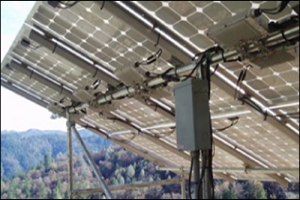 Micro inverters address some of the challenges associated with central inverters. Micro inverters are placed on each solar panel as opposed to one central location. See four light tan boxes on each panel at the right (ignore the dark gray box). A "distributed" inverter approach reduces the negative effect of dust, debris, and cloud shade on any one array or on several arrays. With a centralized inverter controlling a whole string of modules (typically 17 or so), if one module or several modules are performing significantly below the others (strings are performance-matched during installation), the power output of the whole string is reduced. With micro inverters, solar modules are installed in "parallel" with only an AC connection (no DC), so issues with any one module will not affect the rest of the array.
Micro inverters address some of the challenges associated with central inverters. Micro inverters are placed on each solar panel as opposed to one central location. See four light tan boxes on each panel at the right (ignore the dark gray box). A "distributed" inverter approach reduces the negative effect of dust, debris, and cloud shade on any one array or on several arrays. With a centralized inverter controlling a whole string of modules (typically 17 or so), if one module or several modules are performing significantly below the others (strings are performance-matched during installation), the power output of the whole string is reduced. With micro inverters, solar modules are installed in "parallel" with only an AC connection (no DC), so issues with any one module will not affect the rest of the array.
The solar array is no longer subject to the "Christmas Light Effect" because it no longer has a single point of failure. As a result, micro inverters do "harvest" more energy than central inverters.. However, in total micro inverters also cost more. Micro inverter companies say the increased cost is more than worth it and have made significant inroads into small to medium-sized systems. Another micro inverter advantage is remote real time tracking ability. Since each module has an inverter which contains communication electronics, maintenance purposes can see exactly how each panel is performing on a remote customer computer.
Central Inverters VS. Micro Inverters
There is some friendly controversy between large inverter companies and micro inverter companies. Some people use the analogy that the micro inverter entrance is akin to the PC revolution in the computer industry. This may or may not be true. Some of the micro inverter advantages in smaller installations do not hold in utility-size operations. Here are the advantages of central inverters:
Solar panels produce direct current (DC). Almost all customer devices use alternating current (AC). The main function of an inverter is to convert DC into AC. There are two types of inverters: those that are tied to the grid and those that are stand-alone inverters. We shall be discussing only inverters that tie into the grid. Inverters come in a large array of sizes from a home inverter shown on the right to a commercial inverter on the right, to a utility-size mega-watt inverter shown below.


Homes and businesses that have a grid-tied solar system sell the excess electricity that they generate back to the utility. This is known as "netmetering". The entity that owns the solar equipment receives compensation from the utility for the outflow of power. For example if during a month, a solar power system feeds 500 kilowatt-hours into the grid and uses 950 kilowatt-hours (approximately the national average) from the grid. It would only owe 450 kilowatt-hours worth to the utility.
A two-way meter is required for net metering. In essence, when excess solar power is generated, the inverter feeds the grid through the meter, which runs backward selling the power back to the utility at the same price as it is purchased. Net-metering policies vary somewhat from state to state. Inverters do not provide backup power during power outages. For safety reasons, if the grid has lost utility power, the inverter will automatically shut down to prevent the current it produces from harming workers who are sent to restore power.
Solar inverters perform three major functions: as mentioned above they convert the current from DC to AC, they ensure that the solar current and voltage are synchronized with the grid, and they perform Maximum Power Point Tracking (MPPT). Inverters take the DC power from the solar string (typically 300 to 600 volts DC) and invert it to AC power so it can be fed into the grid. The inverter synchronizes its frequency with that of the grid (e.g. 60 cycles) using a local oscillator. It must also match the voltage to the grid voltage. The inverter's AC phase angle must be within 1 degree of the power grid’s AC. The inverter has an onboard computer which will sense the grid's AC current waveform, and output a voltage to correspond exactly to the grid's. The Power-One inverter shown on the right supports utility-scale grid installations.
MPPT - Solar inverters include MPPT (Maximum Power Point Tracking) which enables the inverter to extract an optimal amount of power from the solar string by calculating the array's Maximum Power Point (MPP). Each string of solar panels will have its own MPP. MPPT seeks the "unique current" that the inverter will draw from the string optimize power output (power equals voltage times current).
 In the graph pictured on the right below, V-max is determined by the relatively constant string voltage (the goal is 600 volts - the maximum allowed in the US). I-max is calculated by the inverter to output P-max - the MPP. To find the point where the string produces maximum power, the inverter uses a trial and error algorithm adjusting the current it intakes in one direction and then another. If the power increases, it keeps going in that direction.If the power decreases, it reverses its direction. This is a dynamic situation as the string voltage can vary over time, such as when a cloud obstructs the sun's radiance. Each inverter has a Peak Power Tracking Voltage rating. This represents the DC voltage "range" in which the inverters' MPPT will operate. The installation designer must configure the strings so that during most of the year the voltage of the strings is within the Peak Power Tracking Voltage range. This can be a challenging task as string voltages can fluctuate as much as 35% as a result of swings in ambient temperature.
In the graph pictured on the right below, V-max is determined by the relatively constant string voltage (the goal is 600 volts - the maximum allowed in the US). I-max is calculated by the inverter to output P-max - the MPP. To find the point where the string produces maximum power, the inverter uses a trial and error algorithm adjusting the current it intakes in one direction and then another. If the power increases, it keeps going in that direction.If the power decreases, it reverses its direction. This is a dynamic situation as the string voltage can vary over time, such as when a cloud obstructs the sun's radiance. Each inverter has a Peak Power Tracking Voltage rating. This represents the DC voltage "range" in which the inverters' MPPT will operate. The installation designer must configure the strings so that during most of the year the voltage of the strings is within the Peak Power Tracking Voltage range. This can be a challenging task as string voltages can fluctuate as much as 35% as a result of swings in ambient temperature.Efficiency - Most inverters have efficiencies between 94% and 98%. The energy lost during inversion is converted into heat. For an inverter to output its rated amount of power, it will need to have a power input that exceeds the rated output. For example, a 5,000W rated inverter operating at 95% efficiency will need to consume 5,263 watts (rated power of 5,000 divided by 95%) from the string.
Anti-islanding protection - Normally, solar inverters will shut off if they do not detect the presence of the grid. If however, there are circuits in the electrical system that happen to resonate at the frequency of the grid, the inverter may be fooled into thinking that the grid is still active even though it has been shut down. This is called "islanding". An inverter designed for grid operation will have anti-islanding protection built in. It will inject small pulses that are slightly out of phase into the AC system to cancel any stray resonances that may be present after the grid has shut down. If it does not detect any signal, it will then shut itself down.
 Micro inverters address some of the challenges associated with central inverters. Micro inverters are placed on each solar panel as opposed to one central location. See four light tan boxes on each panel at the right (ignore the dark gray box). A "distributed" inverter approach reduces the negative effect of dust, debris, and cloud shade on any one array or on several arrays. With a centralized inverter controlling a whole string of modules (typically 17 or so), if one module or several modules are performing significantly below the others (strings are performance-matched during installation), the power output of the whole string is reduced. With micro inverters, solar modules are installed in "parallel" with only an AC connection (no DC), so issues with any one module will not affect the rest of the array.
Micro inverters address some of the challenges associated with central inverters. Micro inverters are placed on each solar panel as opposed to one central location. See four light tan boxes on each panel at the right (ignore the dark gray box). A "distributed" inverter approach reduces the negative effect of dust, debris, and cloud shade on any one array or on several arrays. With a centralized inverter controlling a whole string of modules (typically 17 or so), if one module or several modules are performing significantly below the others (strings are performance-matched during installation), the power output of the whole string is reduced. With micro inverters, solar modules are installed in "parallel" with only an AC connection (no DC), so issues with any one module will not affect the rest of the array. The solar array is no longer subject to the "Christmas Light Effect" because it no longer has a single point of failure. As a result, micro inverters do "harvest" more energy than central inverters.. However, in total micro inverters also cost more. Micro inverter companies say the increased cost is more than worth it and have made significant inroads into small to medium-sized systems. Another micro inverter advantage is remote real time tracking ability. Since each module has an inverter which contains communication electronics, maintenance purposes can see exactly how each panel is performing on a remote customer computer.
Central Inverters VS. Micro Inverters
There is some friendly controversy between large inverter companies and micro inverter companies. Some people use the analogy that the micro inverter entrance is akin to the PC revolution in the computer industry. This may or may not be true. Some of the micro inverter advantages in smaller installations do not hold in utility-size operations. Here are the advantages of central inverters:
- Central inverters are less expensive than micro inverters in total.
- Higher transmission voltages are more efficient than lower voltages and have a cost advantage, and most utility electricity is already moved this way.
- Central inverters are better at interfacing and monitoring negative events on the grid.
- Utility and large commercial centers are out in the open and shading (except for cloud cover) is not an issue.
- Utilities are already very sophisticated in the management of their sites and tracking as many as 50,000 thousand individual micro inverters on a 10 MW site is not practical.
- The large commercial and utility markets are forecast to grow faster than the residential market.
- Micro inverters do harvest more electricity, estimated to range from 5% to 20%.
- Micro inverters output AC directly from each panel, so there is no need for DC wiring, etc. Installer electricians and their companies like AC which they are very familiar with in most of their normal applications.
- There is no single point of failure in a micro inverter system. An inverter failure affects only a tiny fraction of the system.
- Voltages are only 240 volts AC which are much safer for technicians than 600 volts DC, plus the whole system can be shut down for repairs. A central system is "live" and dangerous as long as the sun is shining.
- Micro inverters are much more flexible when it comes to roofs with shading, east and west slopes, odd shapes, etc.
- Large micro inverter systems do not require a huge enclosure with a concrete pad, large cooling fans, and isolation for safety's sake.
- Data collection systems down to the panel level are very advantageous from a maintenance point of view to medium-size commercial customers.
Post a Comment:
You may also like:
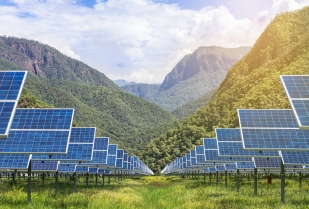
Category
Featured Articles
Expanding Research on Solar Energy ...
The application fields of solar energy are very wide, covering many fields such as the photonic industry, new energy photothermal ...
Exploring Concentrated Solar Power ...
Concentrated Solar Power (CSP) systems use very different technology than photovoltaic systems. CSP systems use the sun as the ...
Solar Cell Manufacturing Process
Solar cells are made of various materials, the most common of which include silicon, indium gallium, cadmium selenide, etc. These ...
The Evolution of Grid Electricity ...
"Electricity" cannot be stored on the grid; generation must be approximately equal to consumption at all times. However, ...
Solar Activity: Sunspots, Magnetism & ...
Solar activity refers to a series of complex phenomena in the solar atmosphere, including sunspots, flares, prominences, coronal ...
